“Vais-je perdre mon classement dans Google si je déplace mon blog ?” C’est la question numéro un que nous entendons chaque fois que quelqu’un envisage de passer de Blogger à WordPress.
Nous comprenons – mais après avoir aidé d’innombrables blogueurs à faire cette transition, nous pouvons vous dire en toute confiance : il est tout à fait possible de passer de Blogger à WordPress sans sacrifier votre classement dans Google.
Au fil des ans, nous avons affiné le processus de migration afin de protéger votre référencement tout en mettant à niveau vers une plateforme de blog plus puissante. À force d’essais et d’erreurs, nous avons trouvé exactement ce qu’il faut faire (et ce qu’il faut éviter !) pour protéger votre place durement gagnée dans les résultats de recherche de Google.
Dans ce guide, nous allons vous présenter notre méthode éprouvée pour passer de Blogger à WordPress. Vous apprendrez les mêmes techniques que celles que nous avons utilisées pour aider d’innombrables blogueurs comme vous à mettre à niveau leurs sites sans sacrifier leur visibilité dans les moteurs de recherche.
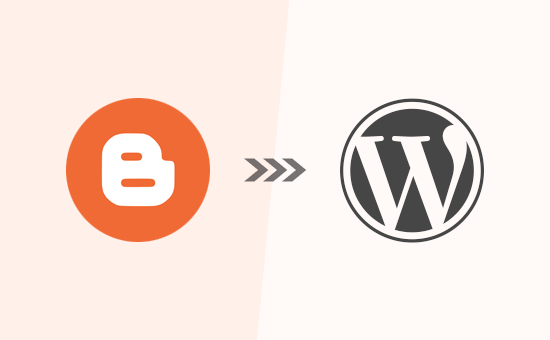
Pourquoi passer de Blogger à WordPress ?
Vous utilisez donc actuellement Blogger, une plateforme de blogs populaire créée par Google qui permet à tout un chacun de créer un blog gratuit à l’aide de son compte Google.
C’est un excellent point de départ pour beaucoup, mais beaucoup de débutants se rendent rapidement compte que leur blog Blogger gratuit peut sembler un peu limité. Vous vous trouverez peut-être dans l’impossibilité d’en faire plus.
C’est là que WordPress entre en jeu. Contrairement à Blogger, WordPress.org vous donne un contrôle total sur votre site. Il vous permet également d’ajouter les fonctionnalités nécessaires avant de développer votre blog et de gagner de l’argent en ligne. Et lorsqu’il s’agit de se faire remarquer sur Google, WordPress.org vous permet d’effectuer tous les ajustements SEO importants pour améliorer votre classement.
En savoir plus ? Nous avons mis en place une comparaison détaillée entre WordPress et Blogger, afin que vous puissiez voir toutes les différences.
Selon nos statistiques de recherche, WordPress est la plateforme de site web la plus populaire au monde et équipe près de 43 % de tous les sites web.
Cela signifie que lorsque vous choisissez WordPress, vous rejoignez des millions d’autres sites bien conçus. Vous choisissez une plateforme à laquelle des tonnes de gens font confiance et qui est parfaite pour mettre en valeur votre contenu.
Cela dit, il existe deux types de logiciels WordPress, et il est donc important de choisir le bon.
Le premier est WordPress.com, un constructeur de sites hébergés. Avec WordPress.com, vous n’avez pas besoin de trouver votre propre offre d’hébergement et d’installer le logiciel vous-même. Au lieu de cela, vous pouvez choisir une offre gratuite ou acheter l’une des offres payantes disponibles, et Automattic hébergera votre site pour vous.
Il y a ensuite WordPress.org, qui est également connu sous le nom de WordPress auto-hébergé. Nous recommandons toujours l’utilisation de WordPress.org car, contrairement à WordPress.com, vous n’avez pas besoin de payer un programme onéreux pour pouvoir installer des extensions (considérez-les comme des modules supplémentaires pour votre nouveau site WordPress !)
Ceci étant dit, voyons comment passer correctement de Blogger à WordPress tout en préservant votre classement dans les moteurs de recherche Google et le trafic de votre site.
Voici toutes les étapes que nous allons aborder pour que votre passage de Blogger à WordPress se fasse en douceur et dans le respect des règles de référencement :
- Step 1. Sign up for WordPress Hosting
- Step 2. Export Your Blogger Blog
- Step 3. Import Blogger to WordPress
- Step 4. Setting Up Permalinks
- Step 5. Set Up Redirects From Blogger to WordPress
- Step 6. Moving Other Content From Blogger to WordPress
- Step 7. Things to Do After Migrating From Blogger to WordPress
- Video Tutorial
Vous êtes prêts ? Premiers pas.
Étape par étape : S’inscrire à l’hébergeur WordPress
Pour Premiers pas avec WordPress, vous aurez besoin d’un nom de domaine et d’un hébergeur.
Pour rappel, un nom de domaine est l’adresse de votre site web que les internautes tapent pour accéder à votre blog, et l’hébergeur est l’endroit où sont stockés les fichiers de votre site. Ces deux éléments sont indispensables pour créer n’importe quel type de blog ou de site.
Cela dit, nous recommandons d’utiliser Bluehost. C’est l’une des plus grandes entreprises d’hébergement au monde, et c’est un partenaire d’hébergement WordPress officiellement recommandé.
Parce que WPBeginner est le plus grand site de ressources WordPress, ils ont accepté d’offrir à nos lecteurs un nom de domaine gratuit et une remise de 60% sur l’hébergeur. En gros, vous pouvez Premiers pas pour seulement 1,99 $ par mois.
Si vous préférez opter pour une alternative à Bluehost, nous vous recommandons d’utiliser soit SiteGround, soit Hébergeur car ce sont tous deux d’excellentes solutions (en fait, nous utilisons SiteGround pour héberger WPBeginner !).
Une fois que vous avez souscrit au plan d’hébergement WordPress et configuré votre nom de domaine, vous pouvez passer à l’étape d’installation de WordPress.
Si vous vous inscrivez chez Bluehost en utilisant notre lien ci-dessus, ils installeront WordPress pour vous automatiquement.
Si vous avez utilisé un autre fournisseur d’hébergement WordPress, vous devez alors installer WordPress en suivant notre guide ultime sur l’installation de WordPress.
Après avoir installé WordPress, il est temps de transférer votre contenu de Blogger vers WordPress.
🧑💻 Nous vous avons entendu haut et fort ! Parce que vous avez été nombreux à nous le demander, nous sommes ravis de vous annoncer que nous offrons désormais un service de migration Blogger vers WordPress totalement GRATUIT dans le cadre de la configuration gratuite de votre blog WordPress! C’est exact – l’un des membres de notre équipe d’experts s ‘occupera de tout pour vous, gratuitement. Vous pouvez littéralement passer de Blogger au monde puissant de WordPress sans aucun souci ni risque.
Notre service gratuit de migration vers Blogger est parfait pour les petits blogs comptant moins de 1 000 publications. Si vous avez un site Blogger plus important, ne vous inquiétez pas ! Nous pouvons toujours vous aider avec la migration, mais il s’agirait d’un service payant.
Étape par étape : Exportation de votre blog Blogger
La première chose à faire est d’exporter le contenu de votre blog Blogger. Vous pouvez le faire en vous rendant sur le site de Blogger et en vous connectant au tableau de bord de votre compte.
Ensuite, rendez-vous sur la page Réglages. Défilez vers le bas jusqu’à la section ” Gérer le blog ” et cliquez sur le bouton ” Sauvegarder le contenu “.
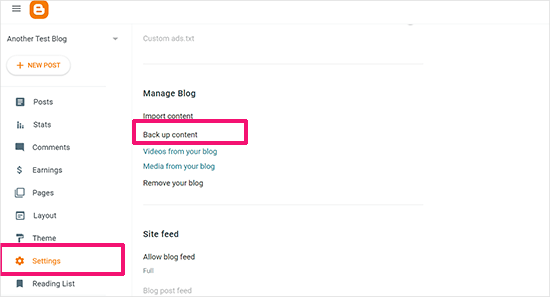
Une fenêtre surgissante s’affiche alors, affichant ce qui est exactement inclus dans la sauvegarde Blogger.
Vous devez cliquer sur le bouton “Télécharger” pour continuer.
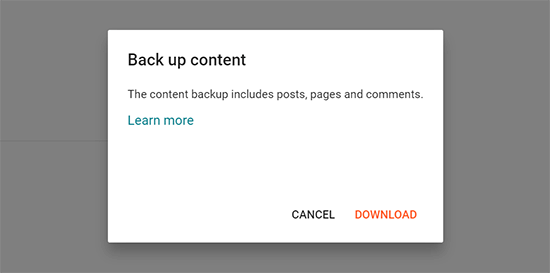
Le contenu de votre blog Blogger sera téléchargé sur votre ordinateur dans un fichier XML.
Une fois le téléchargement terminé, il est temps d’importer votre contenu Blogger sur votre site WordPress.
Étape par étape : Importation de Blogger dans WordPress
Pour commencer à importer votre site Blogger dans WordPress, connectez-vous à votre espace d’administration WordPress et visitez Outils ” Importer.
Sur la page d’importation, cliquez sur le lien “Installer maintenant” en dessous de Blogger.
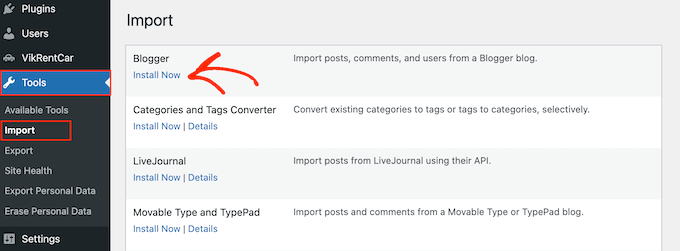
WordPress va maintenant télécharger et installer l’extension Outil d’importation de Blogger pour vous.
Une fois l’installation terminée, vous devez cliquer sur le lien “Exécuter Outil d’importation” pour continuer.
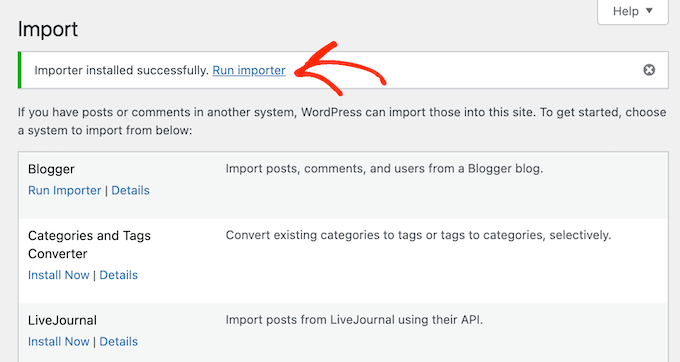
WordPress vous demandera de téléverser le fichier XML sur l’écran d’importation de Blogger. Il s’agit du fichier que vous avez téléchargé à l’étape par étape.
Cliquez simplement sur le bouton “Choisissez un fichier” et téléversez le fichier XML que vous avez téléchargé précédemment.
Cliquez ensuite sur le bouton “Téléverser le fichier et l’importer” pour continuer.
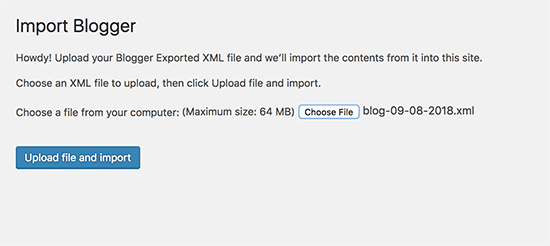
WordPress va maintenant téléverser le fichier d’importation. Si votre fichier d’importation est trop volumineux, un message d’erreur peut apparaître.
Dans ce cas, vous devrez augmenter votre limite maximale de téléversement de fichiers. Si votre fichier est de petite taille, vous ne verrez pas d’erreur.
Ensuite, il vous sera demandé d’assigner des publications à une auteur/autrice. Si vous avez plusieurs auteurs/autrices sur votre blog Blogger, vous pouvez créer un nouveau compte utilisateur pour chaque auteur/autrice. Vous pouvez également assigner ces publications à des auteurs/autrices existants sur votre site WordPress.
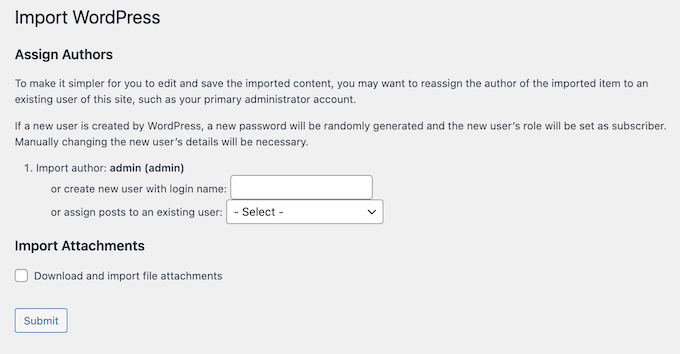
Une fois votre sélection effectuée, cliquez sur le bouton “Envoyer” pour continuer.
WordPress importera tout le contenu du fichier d’exportation Blogger sur votre site WordPress. Vous pouvez voir le contenu en visitant la page “Posts” “All Posts “.
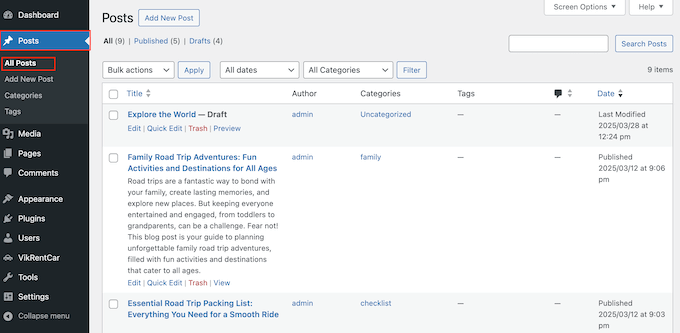
Étape par 3 : Configurer les permaliens
Les permaliens sont le terme utilisé pour désigner la structure URL des pages individuelles. WordPress est doté d’une fonctionnalité qui vous permet de configurer une structure d’URL favorable au référencement.
Étant donné que vous importez du contenu depuis Blogger, il faut que la structure de votre URL soit aussi proche que possible de celle de votre ancien site Blogger.
Pour définir les permaliens, vous devez vous rendre dans Réglages ” Permaliens dans votre tableau de bord WordPress et choisir l’option ” Structure personnalisée “.
Ensuite, vous devez ajouter le texte suivant dans la case située à côté du champ de structure personnalisé :
1 | /%year%/%monthnum%/%postname%.html |
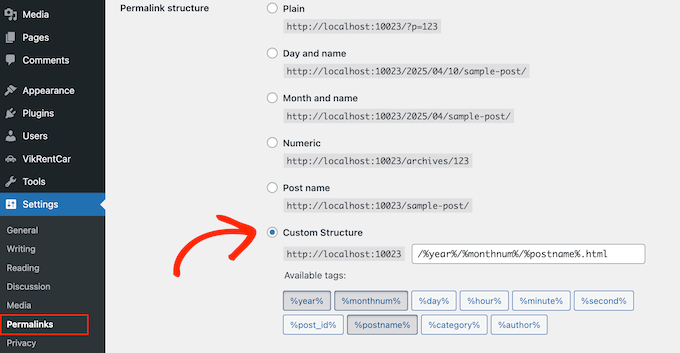
Cette structure permalienne rend les URL de vos publications de blog similaires à celles de votre ancien blog Blogger.
Cependant, il arrive que l’URL de votre publication, également appelée ” slug” dans WordPress, ne corresponde pas aux “slugs” utilisés par Blogger.
Pour corriger ce problème, vous devrez créer et exécuter un petit extrait de code.
Nous vous recommandons d’ajouter ce code PHP à l’aide de l’extension WPCode. C’est le moyen le plus sûr d’ajouter du code personnalisé à votre site WordPress. Pour plus de détails, veuillez consulter notre guide sur la façon de copier et coller des extraits de code dans WordPress.
1 2 3 4 5 6 7 8 9 10 11 12 13 14 | add_action( 'init', 'wpb_update_slug' );function wpb_update_slug() {global $wpdb;$result = $wpdb->get_results("SELECT post_id, meta_value FROM $wpdb->postmeta WHERE meta_key = 'blogger_permalink' ");$wpdb->print_error();foreach ($result as $row){$slug = explode("/",$row->meta_value);$slug = explode(".",$slug[3]);$wpdb->query("UPDATE $wpdb->posts SET post_name ='$slug[0]' WHERE ID = '$row->post_id' ");}echo "DONE";} |
Après avoir enregistré le code, il vous suffit de visiter n’importe quelle page de votre site WordPress pour déclencher ce script. Une fois le script exécuté, n’oubliez pas de le désactiver ou de le supprimer de votre bibliothèque WPCode car il ne doit s’exécuter qu’une seule fois.
Étape par 4 : Configurer les redirections de Blogger vers WordPress
L’étape la plus importante dans le déplacement de tout site Web est de configurer une redirection appropriée afin de ne pas perdre le trafic existant ou les classements SEO. Vous pouvez consulter notre liste de contrôle ultime pour la migration SEO de WordPress pour plus de détails.
⚠️ Si votre blog Blogger a son propre domaine personnalisé au lieu de blogspot.com, vous devrez peut-être faire pointer les serveurs de noms de votre domaine vers votre fournisseur d’hébergement. Pour obtenir des instructions, veuillez suivre notre tutoriel sur la manière de passer d’un blog Blogger à domaine personnalisé à WordPress.
La partie cruciale de la redirection est de s’assurer que vos utilisateurs/utilisatrices atterrissent sur la même page du nouveau domaine que celle à laquelle ils essayaient d’accéder sur l’ancien site.
Parallèlement, vous devez vous assurer que les moteurs de recherche comprennent que votre site a été déplacé vers ce nouvel emplacement.
Pour ce faire, vous devez installer et activer l’extension Blogger to WordPress Redirection. Pour plus de détails, consultez notre guide étape par étape sur l ‘installation d’une extension WordPress.
Une fois activé, vous devez vous rendre sur la page Outils ” Redirection Blogger vers WordPress et cliquer sur le bouton ” Démarrer la configuration “.
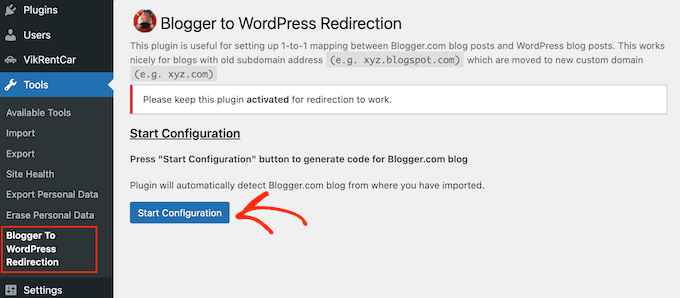
L’extension va maintenant détecter l’URL de votre blog Blogger et vous afficher la faculté d’obtenir un code de redirection. Cliquez sur le bouton “Obtenir le code” à côté de l’URL de votre blog.
Il va maintenant générer un extrait de code dont vous avez besoin pour rediriger correctement les utilisateurs/utilisatrices de votre ancien blog Blogger vers votre nouveau site WordPress.
Ensuite, vous devez vous connecter à votre Tableau de bord Blogger et vous rendre sur la page ‘Thèmes’. Cliquez sur la flèche déroulante du bouton ” Personnaliser ” à côté de votre thème, puis sélectionnez l’option ” Modifier le HTML “.
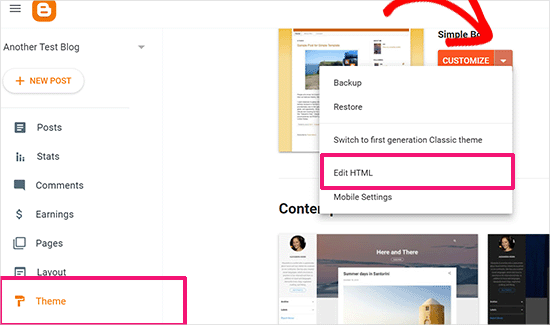
Blogger affiche maintenant le code HTML personnalisé de votre modèle de thème. Si vous avez personnalisé votre thème Blogger, vous pouvez copier le code et l’enregistrer sur votre ordinateur à titre de sauvegarde.
Sinon, vous pouvez simplement aller de l’avant et tout effacer. Ensuite, copiez le code affiché par l’extension sur votre site WordPress et collez-le dans l’éditeur/éditrices de votre thème Blogger.
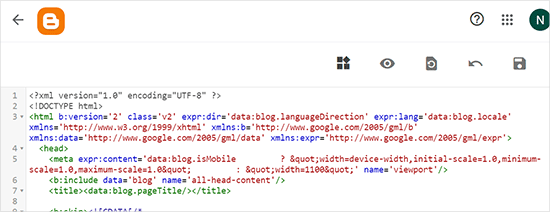
N’oubliez pas de cliquer sur le bouton “Enregistrer le thème” pour stocker vos modifications.
Ensuite, nous devons définir des redirections pour les utilisateurs/utilisatrices mobiles.
Vous devez retourner à la page Thèmes dans le tableau de bord de votre blog Blogger. Cette fois, vous devez cliquer sur le bouton d’engrenage situé sous la prévisualisation mobile de votre blog.
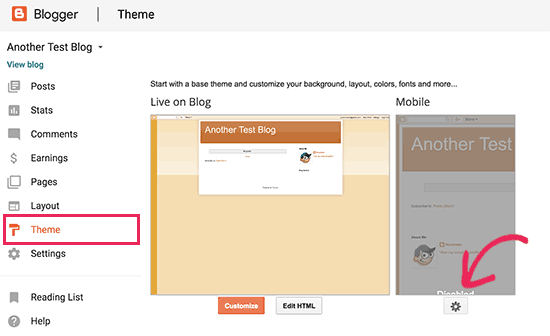
Une fenêtre surgissante s’affiche dans laquelle vous devez sélectionner l’option “Aucun. Afficher le thème de l’ordinateur sur les appareils mobiles”.
Cliquez ensuite sur le bouton “Enregistrer”.
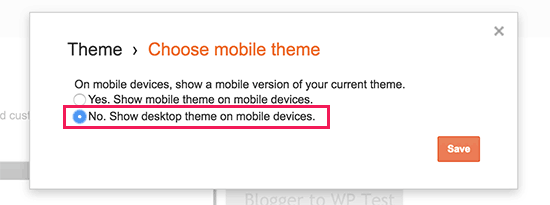
C’est tout, votre blog Blogger va maintenant rediriger tous les internautes vers votre nouveau blog WordPress.
Vous pouvez également utiliser All in One SEO (AIOSEO) pour rediriger les publications et les pages de Blogger vers WordPress. L’extension offre une puissante fonctionnalité de gestionnaire de redirection qui vous permet de configurer des redirections de site complètes vers votre nouveau site.

De plus, vous pouvez activer le suivi des erreurs 404 et repérer les liens brisés qui pourraient survenir lors de la migration de votre site vers WordPress. Cela aidera à améliorer le compte des utilisateurs/utilisatrices, et vous ne perdrez pas le classement des mots-clé.
Nous utilisons AIOSEO pour gérer toutes nos pages et publications WPBeginner – et honnêtement ? Nous avons été époustouflés par les résultats. C’est pourquoi c’est notre recommandation pour vous tous.
Pour en savoir plus sur nos expériences, consultez notre Avis détaillé sur l ‘AIOSEO.
Étape par étape : Transférer d’autres contenus de Blogger vers WordPress
Dans cette étape, nous allons déplacer le contenu restant de l’ancien blog sur Blogger vers votre nouveau blog WordPress. Cela peut nécessiter un certain travail manuel, en fonction des réglages/contenus de votre blog.
1. Déplacer des pages de Blogger vers WordPress
L’outil d’importation Blogger de WordPress importe uniquement les publications Blogger et ignore les pages.
Pour transférer vos pages dans WordPress, vous devrez modifier chaque page de votre blog Blogger, copier son contenu, puis créer manuellement une page dans WordPress.
Pour en savoir plus sur les pages, consultez notre article sur la différence entre les publications et les pages dans WordPress.
Vous allez maintenant rencontrer un autre problème. Les pages Blogger ont des URL qui ressemblent à ceci :
À PROPOS : http://example.blogspot.com/p/about-us.html
L’URL de votre page WordPress ressemblera à ceci :
http://example.com/about-us
Pour corriger ce problème, vous devrez utiliser l’extension All in One SEO (AIOSEO). Pour obtenir des instructions, veuillez consulter notre guide du débutant sur la création de redirections dans WordPress.
2. Widgets
À l’instar de Blogger, certains thèmes WordPress utilisent également des widgets pour ajouter du contenu à la colonne latérale de votre blog.
Pour ajouter des widgets, vous devez vous rendre sur la page Apparence ” Widgets dans votre tableau de bord WordPress et simplement glisser/déposer des widgets dans les colonnes latérales. Pour des instructions détaillées, consultez notre guide sur l’ajout et l’utilisation de widgets dans WordPress.
Si vous recherchez un widget spécifique que vous ne voyez pas dans WordPress par défaut, alors vous avez probablement besoin d’une extension WordPress. Vous pouvez rechercher dans la catégorie des meilleures extensions WordPress de WPBeginner pour trouver la fonctionnalité que vous souhaitez.
3. Flux RSS
Les moteurs de recherche et les utilisateurs/utilisatrices abonnés/abonnées à vos publications de blog via les flux RSS pourront toujours trouver votre blog. Cependant, ils ne recevront pas de nouveau contenu.
Pour corriger ce problème, rendez-vous sur la page Réglages de votre compte Blogger. Défilez ensuite jusqu’à la section “Flux du site” et cliquez sur “Post feed redirect URL”.
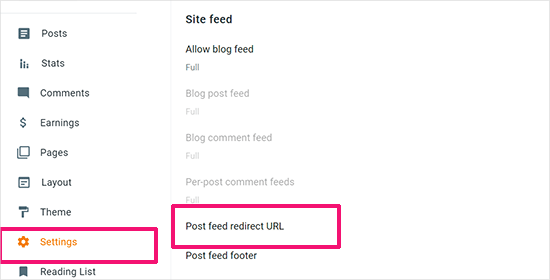
Une fenêtre surgissante apparaît, dans laquelle vous devez ajouter l’URL du flux RSS de votre site WordPress.
L’URL de votre flux WordPress ressemblera à ceci :
http://example.com/feed
N’oubliez pas de remplacer exemple.com par votre propre nom de domaine.
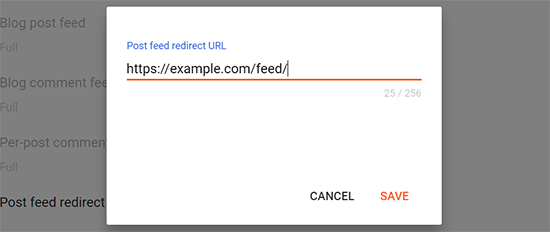
Cliquez sur le bouton “Enregistrer” pour ajouter l’URL et enregistrer vos Réglages.
Étape par étape. Choses à faire après la migration de Blogger vers WordPress
Maintenant que vous avez bien transféré votre blog Blogger vers WordPress, voyons ce que vous pouvez faire d’autre pour améliorer votre blog.
Nous avons créé une liste de contrôle des choses les plus importantes à faire après l’installation de WordPress.
WordPress est assez facile à utiliser. Cependant, vous découvrirez parfois de nouvelles choses pour lesquelles vous aurez besoin d’aide. C’est là que WPBeginner intervient.
WPBeginner est le plus grand site de ressources WordPress gratuites au monde. Nous publions régulièrement des tutoriels et des guides écrits spécifiquement pour les blogueurs et les petites entreprises.
Voici quelques-unes des ressources utiles que vous trouverez sur WPBeginner (toutes sont gratuites) :
- WPBeginner Blog – L’endroit central pour tous nos tutoriels et guides WordPress.
- WPBeginner Dictionary – Notre glossaire WordPress est le meilleur endroit pour se familiariser avec le jargon WordPress.
- Vidéos WPBeginner – Les nouveaux utilisateurs/utilisatrices de WordPress peuvent commencer avec ces vidéos étape par étape pour maîtriser WordPress.
- WPBeginner sur YouTube – Besoin de plus de vidéos d’instructions ? Abonnez-vous à notre chaîne YouTube qui compte plus de 291 000 abonnés/abonnés et plus de 50 millions de vues.
- WPBeginner Blueprint – Découvrez les extensions, les outils et les services que nous utilisons sur WPBeginner.
- WPBeginner Deals – Remises exclusives sur des produits et services WordPress pour les utilisateurs/utilisatrices WPBeginner.
Tutoriel vidéo
Nous espérons que cet article vous a aidé à passer de Blogger à WordPress sans affecter votre classement dans les recherches Google. Vous pouvez également consulter notre guide pour savoir quelle offre WordPress vous devriez utiliser ou les mythes WordPress les plus courants démystifiés.
Si vous avez aimé cet article, veuillez alors vous abonner à notre chaîne YouTube pour obtenir des tutoriels vidéo sur WordPress. Vous pouvez également nous trouver sur Twitter et Facebook.





Nathan
If you do the swap from Blogger to self-hosted, are the existing pageviews being transferred over to the new website – or will you have to start from 0 all over again?
Stephan
Verz good this article but I have some problems.
I have AdSense on my website and as I have seen AdSense code and Google Analytics code were not imported from the blogger posts in the wordpress posts. What should I do? To edit again all the posts I have and add those two codes?
During the conversion of blogger to wordpress posts AdSense code and google analytics code are not taken?
WPBeginner Support
Hi Stephan,
Google Analytics works on domain names, so you will need to add a new Google Analytics profile to keep tracking traffic on your new WordPress site.
As for AdSense, Blogger accounts usually have hosted AdSense accounts. You will need to upgrade your AdSense account. Simply login to your AdSense dashboard and then go to My Ads and click on Other Products, click Upgrade now and complete the application form.
You will need to regenerate AdSense ads code and add them to your new WordPress site. See our guide on how to properly add Google AdSense in WordPress.
Admin
devendra
Now anyone visiting a post on your old Blogger blog will be redirected to the same post on your new WordPress site. ……
What is mean by this……..redirect on a single post only.
Petra
One question – when I move my content to WordPress, do I delete my old blog in Blogger or not? Some say yes cause Google doesn’t like the same content on both pages (something like that), some say no cause all your pics are going to be deleted… I’m confused.. Do redirections even have sense if you delete your old blog? Confused again. Thank you for your answer! ☺
Khaliff Mogaji
Hi,
I have followed the instructions step by step but my blogger blog redirects to the homepage of my wordpress blog instead of it to redirect to the exact post on the wordpress site.
Min-Chi Hsieh
Hi,
Really appreciate for this article… But, I have one question needs your help…
I moved my blog to wordpress one year before and everything was good… But, when I changed the theme, I edited my functions.php as last time, it showed undefined index, pointed to this line “$blogger = $wp_query->query_vars[‘blogger’];”
Do you have any suggestion? Thanks~!!
WPBeginner Support
Hi Min-Chi Hsieh,
You can copy the redirect code from your old theme’s functions file and paste it in new theme.
Admin
Min-Chi Hsieh
Hi,
I did it… And it still showed the same note… Any suggestion?
Pengedar Shaklee Farha IbuCergas
hi, the function.php need to be added everytime we change the theme right? because every time i change the theme, it is gone.
WPBeginner Support
Hi Pengedar,
Yes, you will need to paste it in your active theme. If you will be switching themes a lot, then it would be best to create a site-specific plugin and then paste the code inside it.
Admin
Rajat Shankhdhar
Is it really necessary to set permalinks as moth/date in 301 redirect or it’s just looking the post same like in blogger
bethan arundel
Hi, I have an issue that when I go onto my blog spot now after following the steps it just has a big link in the middle of the page that when you click on it it goes to my new wordpress site, but it doesn’t automatically direct. Help would be much appreciated.
Hamid
I wanted to leave my site on .blogspot.com but i discovered some of the interlinks on my blogger blog are not redirecting to the right post on WordPress
Benny
I too encountered this problem.
What I did was I changed the permalink to custom and add
” /%year%/%monthnum%/%postname%.html
”
without quotes
Hope this helps!
Christine
Benny,
THANK YOU SOOOOOOOO MUCH for leaving this comment! I just went through the process on converting over from Blogger and ran into this very issue. I was wondering how the .html translated automatically over to wordpress and realized they didn’t at all! My links posts weren’t re-directing and now they are thanks to you!
Christine
Elisabeth Anggia
Hi dear,
Thank you so much. It works for me.
I keep coming to this place, because your tutorial is easy to follow even for a beginner like me.
Mariusz
Hi. Thanks for your tutorial.
Something strange happened to my blog. When I look on mobile version I see all posts from blogger. but on desktop version some posts are hidden. How can make them visible – can you help me? In WP admin I cannot see it as well…
Marianne
Hello! Thanks for the great tutorial. I set up the redirects and I think there is an issue with it redirecting to the www. vs without www. Do you know how to fix this?
Heather
I am having the same issue, have you found a way to fix this?
Lori
I’m going to use a theme on my wordpress site – do I integrate that before or after I transfer blogger site over.
WPBeginner Support
Hi Lori,
You can do that later. This will give you a clear idea of how your content looks when its imported and how you’d like to set it up.
Admin
udayvir singh
Thanks for great tutorial.
I have done almost all the job, but there s a problem, My all blogger posts are perfectly redirecting on proper WordPress url but blogger pages urls (www.example/p/pageurl/) are not not redirecting to right path (www.example/pageurl/).
Please help me..if there is any way to deal with the issue.
WPBeginner Support
Hi Udayvir,
Please take a look at our guide on how to setup redirects in WordPress.
Admin
Sin Yee
This article helps much! Have successfully migrate everything to the new hosting. Did the redirect too! Thank you so much!
abu sufian
I try to uplaod. xml file but after uploading its said all done! have a nice day! and redirected to my admin page. don’t ask author name. what can i do??
WPBeginner Support
You can also change author name manually. Go to Posts and click on the Screen Options button at the top. Select the number of posts you want to display on the page. You can display upto 999 posts at a time. After that click on the Check All checkbox to select all posts displayed on the page. Next, select Quick Edit option from the Bulk Actions drop down menu. This will show you a box where you can change the author name.
Admin
Anindra
Here is what I have:
Blog #1:
1. Hosted on hostgator.com
2. Custom domain registered through hostgator
3. Still active, but I’ve almost abandoned it
Blog #2:
1. Hosted on Blogger
2. Custom domain registered through blogger
3. Still active and I’m using it
I want to replace Blog #1 with Blog #2.
Questions:
1. Is it doable?
2. How?
WPBeginner Support
Hi Anindra,
Yes, it is doable. See the instructions in the article above.
Admin
Sharoon Qadeer
I have tried this but this not redirecting post. All links are redirected to homepage.
Adding code in functions.php shows a code in header and adding code in site-specific plugin it doesn’t work and neither doesn’t redirect to post
Steph
In your Permalink settings paste this code on the custom structure
/%year%/%monthnum%/%postname%.html
Jui Deb
Hello, If i migrate mu blog from blogger to WordPress than will it be copy paste for google?? As i will use same content in my blogger and WordPress blog if i migrate it from blogger to WordPress?
Dina
Hi,
Just wondering if this process will work if I’m transferring from a .blogspot.com to a .wordpress.com site. Not planning on self hosting just yet, but plan to in the future so I figure it’d be easier to switch to wordpress now.
Does this still work?
Dhiraj Kr Yadav
Hi its really helpfull video.I do have a question kindly help me out.I do have a blogger account and its verified from google now i created a blog on wordpress with same same but when i tried to verify my site by google its telling i cant verify it as i do have a blogspot account.kindly help me out.How can i verify my site from google.Kindly guide me and help me out.
with regards.
Dedrick Jordan
If you did not the video, it some pretty simple steps to take, just watch the video, and it shows you what u need to do, and you should be using WordPress.org big difference.
Rahul
Hi WP
Thanks for this informative post. I want to move my blogger custom domain blog to wordpress. I had purchased my domain name from GoDaddy and linked it with blogger after reading some tutorials. Can I follow the exact procedure in this post or there are some changes given that I use a custom domain name? Pls reply! Thanks
Chuks Amobi
Blogger images always have a long string of characters instead of the original image name. My question is, will the images be exported to WP with the same long string image name or the original image name?
Hans ganteng
Hi nice share guy, btw I have one question. Is it possible setting permalink on wordpress same with blogger So I dont need set redirect 301?
Example on WP blabla com/%month%/%date%/%postname%.html, I mean replacing slash (/) to .html ?
Thank you
Ernest
I like this tutorial and I am reading it with keen interest because I have a blogger site that is running on the blogger URL. Please I want to know if I can do the transfer with that URL or the site must be on custom domain, as recommended by other writers.
Lauren Alyce
Thanks for the information, it was very helpful. Just converted my blogger to WordPress today. I used a plugin that helped me generate the code for my blogger template called Blogger to WordPress so I didn’t have to make any changes to my themes function files on my own. This could be an option for the people that are getting errors.
Ernest
Dear Lauern, I think your comment makes sense to me since WPbeginner have not responded to my inquiry I decide to ask you this; can I do the migration with my blogger.com domain, or do I need a custom domain or my blogger site before going for the migration?
Please, anyone can respond to this question.
WPBeginner Support
Hi Ernest,
If you have a domain name like myblog.blogspot.com, then you can transfer your blog but not the domain name.
On the other hand if your blogger blog have a custom domain like example.com, then you can use that domain on your self-hosted WordPress.org site aswell.
Admin
Dedrick Jordan
I did watch the tutorial you would, have to buy a domain, when you are purchasing a self hosting for wp. But the domain is entirely free, on the other name the self hosting page is really cheap. So that means you could get a whole entire year for less then $60 dollars my man.. Hope the feedback helps
Poorna
Hi,
Thanks for the nice tutorial. Unfortunately, i had moved from blogger to WP before seeing this tutorial. The result is the formatting of content in old posts in blogger and pictures after migration has gone haywire. Is there anything that can be done to make it look good now? Your answer will be very helpful. Thanks in advance.
Emmanuel
I will really love if you fix the code we need to post in blogger because it showing some errors which make it not to save..
Hannah
This article and video is brilliant- thank you so much!
Quick questions, you mention in the video if you choose a new theme, you have to do that specific step again. If I purchase a new wordpress theme and install that, do I need to repeat that step? Or is that step only to be repeated if you change the blogger theme?
Thanks in advance,
Hannah
WPBeginner Support
Hi Hannah,
Glad you found the article helpful.
As for theme changes. If you add any code to WordPress theme files, then you need to save those changes elsewhere as well. If you update your theme or install a new theme then you can copy and paste to add that code to your new WordPress theme.
Admin
Elise
Hello,
I have followed the instructions above to transfer my blog to Bluehost as above, but now want to return to my old blog until I am ready to devote time to working on the WordPress site.
How do I return to my old blog (which is now showing an error message?)
Thank you in advance,
Elise
WPBeginner Support
Hey Elise,
Simply login to your Blogger account and then switch your blogger theme from classic to any newer theme. This will restore your Blogger blog.
Admin
Elise
Brilliant, worked a charm. Thank you!
Carolyn
This is a great tutorial, but I have a couple of questions I hope you can help me with.
I have a blogger blog with it’s own domain name that I bought through Go Daddy.
I want to migrate to WordPress, but I want to do it with a different domain name hosted by Bluehost.
Is there a way to do this without losing google rankings/pinterest links, etc?
WPBeginner Support
Hey Carolyn,
We will recommend you to first move your blog to the old domain name. You can point that domain to Bluehost as well.
Once you have moved your blog to the new location and everything is working fine, then you can easily setup permenant redirects. See our guide on how to how to move WordPress to a new domain without losing SEO
Admin
Carolyn
Thanks for your fast response! I want to make sure I understand your advice.
So as of now, my old blogger blog is still connected to my old domain name on Go Daddy.
And now I have a new domain name on bluehost with a theme set up. But I haven’t migrated any posts over.
Can I let my old domain name expire and not lose SEO?
What do I do next?
WPBeginner Support
Hi Carolyn,
You need to keep your old domain for as long as possible. After few months if you are satisfied that all your traffic is back to normal then you can let the old domain expire. However, keep in mind that anyone can then take over that domain name and they can copy your old content and start outranking your new domain name.
Cindy
Most of my old posts from blogger have a different address in wordpress. When I put in the page redirect code, it not only doesn’t redirect to the right page, but it goes to a Go Daddy page!! I DESPISE Go Daddy, so this is the worst of all worlds.
How do I add coding to the 2nd part of step 4 above to make pages with mismatched addresses just bounce to the homepage of the new blog?
I tried to just undo the page direct and leave it with the general redirect, but I’m still getting the Go Daddy page instead.
WPBeginner Support
Hi Cindy,
Seems like your domain is not properly setup yet. Domain name server changes take some time to propagate. Check your domain name settings to make sure that it is pointing to your WordPress hosting provider’s nameservers.
Admin
Cindy
It’s not a propagation issue. I’ve been using this domain for several years and I have NEVER done business with Go Daddy.
I undid all the site and page redirects and added a couple by hand. That’s not a realistic option though.
As I said, the redirect code recommended here fails because the post names don’t match between blogger and WordPress. (WP mangled the names when I did the import two years ago.) That would be ok if the ones that don’t match would redirect to my WP homepage. Instead it tries to redirect the ones it can’t match up to the myblogname.com portion of the blogger address. I don’t use that name on WP because someone has been sitting on the regular URL for years. (I assume Go Daddy captures the page because the squatted address is registered through them. )
I just need code added to the redirect that tells the net “if you can’t find this post address, go to this page (my WP homepage) instead.”
Lynwood Thorson
Pretty! This has been an incredibly wonderful article. Many thanks for providing this info.
Ashutosh
Hi,
Thanks for the nice and detailed tutorial. I have a question on permalink part.
Blogger urls are like domain/year/month/postname and after migration I hope it will be same.
But what about the new post i will publish on WP? their URL will be also same or I can make like domain/postname?
please assist.
WPBeginner Support
Hey Ashutosh,
Your new posts will use the same URL structure you selected in Step 3 of the article. It will be the same you used on Blogger.
Admin
Maria Skatova
Hi, I am planning to move my blog from Blogger to WordPress and not sure how the migration works with images – does it import original photos from Blogger to WP media library and put them into year/month folders (as WordPress itself does)? Does it mark the photos as ‘attached’ to according posts?
Thank you very muck in advance
Vanita Sosa
Great blog! Do you have any suggestions for aspiring writers? I’m hoping to start my own website soon but I’m a little lost on everything. Would you suggest starting with a free platform like WordPress or go for a paid option? There are so many options out there that I’m completely overwhelmed .. Any tips? Thank you!
WPBeginner Support
Hey Vanita,
We will recommend you to start with a self-hosted WordPress.org site. See our guide on how to start a WordPress blog for complete instructions.
Admin
Kimberly Dsouza
Hi,
I followed your tutorial and redirected my blogger (custom domain) blog to a new domain on WP and everything works fine.
However, when I tried the “change in address tool” in google webmaster, it says
“We couldn’t find any 301-redirect directives for your site”
The “fetch” data shows a “200 OK” response instead of 301 Moved Permanently!
So, how do i correctly do a 301 redirect?!
Lizet
I used your instructions to migrate my blog. I´ve been having so many problem (because I´m very ignorant on all this) and would like to start over again. Is there a way to restorer back my blog on blogger? I´ve call different companies in the country where I live to see if they can fix whatever the problem is with my blog on wordpress, but they don´t want to help me. So I thought if I can restorer my blogger, maybe they can do all the process from the beginning. Thanks for your help!
WPBeginner Support
Hey Lizet,
To restore your blogger blog. Login to the Blogger dashboard and then go to Theme section. Select an apply a new theme and your Blogger blog will be restored.
Admin
Andrea Restrepo
Hello.
I did redirect my blog and it is redirecting with no problems in a pc version but still going to the old blog in my android phone.
Could you please tell me if I need other code??
Sajid Khan
Hey Andrea,
You don’t need any other code just goto your blogger dashboard and then goto theme section. Goto mobile and click on no, show desktop version.
Kazumi
Thank you so much!
I had the same issue with mobile redirection too.
It was so easy but I couldn’t find out the solution!
Nicci
Thank you so much!!!!!!!!!!!!!!!
I used Code Snippets to add code in the functions php file (since I was a bit nervous to try myself) and it works!! Thank you!
tara
I tried to migrate my blogger blog to wordpress and I get this error once trying to import the file:
warning: reset() expects parameter 1 to be array, boolean given in /home2/susanpad/public_html/wp-content/plugins/blogger-importer/blogger-importer.php on line 696
I tried also to use blogger import extended plugin but it duplicates content and images are blurry. Also it doesn’t carry over the read more section.
Help!
Myle
Thanks for your reply. Seem to be getting some problem with importing Blogger posts into WordPress. I have all the plugins installed on Blogger and Blogger Importer Extended. When I click on Tools–>Import –>Blogger–>Run Importer and go through the steps, then press import but it just shows a blank page with the word “Import” in the end. Then when I reload, it says “File is empty. Please upload something more substantial…” Tried a few times with different tweaks but still the same. Could it be the theme or anything wrong with my WordPress ? Anywhere that will show how to solve this issue ?
Nwachukwu
@Myle try backing it up again from your blogger blog, make sure the file is also in the right format.
shahbaz khan
thanks for sharing such a good content.
If i write post after swith from blogger to wordpress then i will post on Blogger or wordpress?
my blogger site will close?
WPBeginner Support
Hi Shahbaz,
No, your Blogger site will still be there but will not be visible to users. You can still login to your Blogger account and see your content.
After you have switched you will post content on your new WordPress site.
Admin
Myle
Once I have imported my blog from Blogger to WordPress, can I still create blog posts from Blogger and will it automatically reflect the latest posts in WordPress ? Or from then onwards, I can only create new blog posts in WordPress ?
WPBeginner Support
No, your blogger blog posts will not be synced to your new WordPress site.
Admin
Navin Rao
This was the best post on migrating from Blogger To WordPress including the video tutorial…
Thanks for sharing… it helped
Navin Rao
chen
The most useful post i’ve read recentlay
Rob
Thanks! This is really helpful and much appreciated. I have subscribed to your youtube channel. Keep up the good work
Srikanth Eswaran
One query, does this article apply if my new domain name is the same one as what was pointing to Blogger earlier? for example if I had 123 dot com pointing to a blogger account, and I set up wordpress to also have the domain 123 dot com, would this redirect now work?
Please let me know.
Prashant
I’ve deleted all posts after running blogger imported, Now it’s not importing anything.